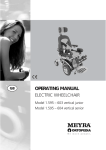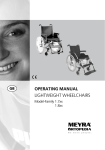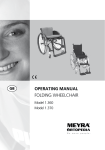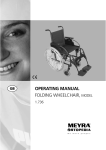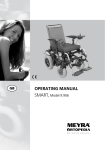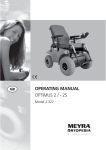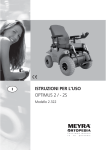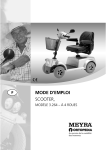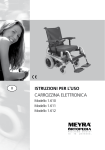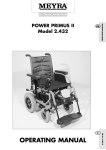Download Meyra 3.600 Specifications
Transcript
GB OPERATING MANUAL STANDARD FOLDING WHEELCHAIR Model 3.600 Model 3.604 We move people. Contents Introduction .................................................................................................. 5 List of models ............................................................................................... 6 Indications..................................................................................................... 6 Acceptance .................................................................................................... 6 Specifications................................................................................................ 7 Use ................................................................................................................. 7 Adjustment ................................................................................................... 8 Life span ........................................................................................................ 8 Overview ....................................................................................................... 9 Model 3.604 ........................................................................................................10 Supplementary safety information.......................................................... 11 Brake ............................................................................................................ 12 Pressure brake - user ..........................................................................................13 Locking the brakes ........................................................................................13 Releasing the brakes .....................................................................................13 Operating brake ............................................................................................13 Drum brake for accompanying persons ...........................................................14 Leg supports ............................................................................................... 15 Calf belt ...............................................................................................................15 Removing the calf belt .................................................................................16 Attaching the calf belt..................................................................................16 Length adjustment of the calf belt..............................................................16 Leg support lower part ......................................................................................16 Footplates ......................................................................................................16 Leg support upper part......................................................................................17 Turning the leg supports to the side ..........................................................17 Swivelling in the leg supports ......................................................................17 Removing the leg supports ..........................................................................18 Attaching the leg supports ..........................................................................18 Height adjustment of the leg support ........................................................19 2 Arm support................................................................................................ 20 Removing the arm support ...............................................................................21 Inserting the arm support..................................................................................21 Height adjustable armrest .................................................................................22 Back support ............................................................................................... 23 Back support with angle adjustment ...............................................................23 30 ° Angle adjustment ..................................................................................23 Removable head support .............................................................................24 Push bar for back support .................................................................................24 Swivelling out the push bar .........................................................................24 Attaching the push bar.................................................................................24 Wheels ......................................................................................................... 25 Drive wheels........................................................................................................25 Quick release axle .........................................................................................25 Wheels with pneumatic tyres ............................................................................25 Tyre damage on pneumatic tyres ................................................................25 Support castors........................................................................................... 26 Stick-in support castors ......................................................................................26 Removing/inserting the support castors .....................................................26 Retaining strap ........................................................................................... 27 Fastening the retaining strap ............................................................................27 Opening the retaining strap..............................................................................27 Adjustment of belt length .................................................................................27 Folding/Unfolding....................................................................................... 28 Folding the wheelchair ......................................................................................28 Carrying the wheelchair ....................................................................................28 Unfolding the wheelchair..................................................................................29 Loading and transportation ...................................................................... 29 Loading ...............................................................................................................30 Transport .............................................................................................................30 Passenger transport in handicapped transport vehicles (HTV) .................30 Transport security ..........................................................................................30 3 Maintenance ............................................................................................... 30 Maintenance .......................................................................................................30 Maintenance schedule ..................................................................................31 Technical data ............................................................................................. 34 Meaning of the labels on the wheelchair ........................................................38 Meaning of the symbols on the type plate ......................................................39 Inspection certificate ................................................................................. 40 Notes............................................................................................................ 41 Warranty / Guarantee................................................................................. 42 Warrantee / Guarantee section .........................................................................43 Inspection certificate for transfer .....................................................................43 4 INTRODUCTION We thank you for the confidence you have placed in our company by choosing a wheelchair from this series. With all equipment and their accessories the wheelchair offers die respective adaptation to your disability. Like any other vehicle, a wheelchair is a technical aid. It is subject to explanations, requires regular care and can cause danger when used improperly. The correct handling must therefore be learned. This operating manual is to help you get accustomed to the handling of the wheelchair as well as to prevent accidents. ☞ Note: Children and juveniles should read the documentation belonging to the wheelchair together with their parents respectively a supervisor or an accompanying person before first use. For users with visual impairments the PDF-files of the above mentioned documents can be accessed on our website < www.meyra-ortopedia.com >. ☞ Contact your specialist dealer when required. Alternatively users with visual impairments can have the documentation read out by a helper. ☞ Note: Please note that the illustrated equipment variants can deviate from your model. We have therefore also listed chapters with options that might not be applicable for your individual wheelchair. ! Attention: Read and observe the following documentation belonging to the wheelchair before first operation: – this operating manual, – Safety and general handling instructions < Mechanical and muscle powered wheelchairs >. 5 LIST OF MODELS ACCEPTANCE This operating manual applies to the following models: All products are checked for faults in the factory and packed in special boxes. Model 3.600 Model 3.604 INDICATIONS If the following indications occur we recommend the application of this mobility product: ☞ Walking disability resp. extremely limited walking ability as part of the basic need to move around in your own home. ☞ The need to be able to leave home for a short walk in fresh air or in order to reach the places, commonly in the perimeter of the home, required to fulfil basic needs. 6 ☞ Note: However, we request that you check the vehicle for possible transport damage immediately on receipt – preferably in the presence of the carrier. ☞ Note: The packaging of the wheelchair should be stored for a further transport that might become necessary. SPECIFICATIONS USE The wheelchair of the standard-folding-wheelchair-family, was developed for adults and adolescents. The wheelchair is universally applicable on level, firm surfaces and can be used as follows: The wheelchair solely serves to transport one person in the seat and not as a hauling aid, transporter or similar. ☞ Note: The wheelchair of the standardfolding wheelchair family is mainly suited for loan or short term use. – for indoors (e.g. apartment, day care), – outdoors (e.g. in parks), – as a companion on tours (e.g. in a bus or train). The wheelchair offers manifold adjustment possibilities to individual vital statistics. The wheelchair should be adapted to your needs by a specialist dealer before the first use. The adaptation will take into account the driving experience, the physical limits of the user and the main place of use of the wheelchair. ! • Attention: Always have adaptation and adjustment work carried out by a specialist dealer. Do not insert fingers into open frame tubes (for example after removing the arm supports, leg supports or support castors). ☞ Danger of injury! 7 ADJUSTMENT LIFE SPAN The specialist workshop will hand out the wheelchair to you under consideration of all relevant safety instructions, ready for operation and adjusted to your needs. We expect an average lifespan of about 4 years for this product, as far as the product is applied for its designated purpose and all maintenance and service guidelines. ☞ Note: ☞ We recommend a regular control The life span of your product depends upon the frequency of use, the application environment and care. if the wheelchair adjustment in order to ensure a long-term optimal provision even with changing illness/handicap patterns of the user. Especially for children and juveniles an adjustment every 6 months is recommendable. ☞ We recommend regular medical exams in order to ensure safety for active participation in traffic. ☞ Retrospective adjustments should be carried out solely by the specialist dealer! 8 The implementation of spare parts can prolong the life span of the product. As a rule spare parts are available up to 5 years after production is discontinued. ☞ The indicated life span does not constitute additional guarantee. OVERVIEW The overview shows, representative for all models, the most important components of the standard-folding-wheelchair. 1 2 3 4 5 12 11 10 9 6 8 Pos. Description 1 2 3 4 5 6 Push handle Back support Arm support Clothes guard Seat belt/seat cushion Footboard/footplates divided 7 Pos. Description 7 Steering wheel 8 Locking lever, leg support 9 Locking knob – Quick release axle 10 Brake lever – pressure brake 11 Handrims 12 Drive wheel 9 Model 3.604 The overview shows deviating components to the standard folding wheelchair. 13 14 15 Pos. Description 13 Head support 14 Stabilising/push bar 15 Angle adjustment of the back support 10 SUPPLEMENTARY SAFETY INFORMATION The following safety information are supplementary to: – Safety and general handling instructions < Mechanical and muscle powered wheelchairs >. ☞ Note: Do not insert fingers into open frame tubes (for example after removing the arm supports, leg supports or support castors). – Danger of injury! ! ! Attention: Scuttling (rolling motion of the wheelchair with help of the feet) is only permitted with creeping rolling speed on horizontal, level surfaces indoors. ☞ In doing so the sitting position may not be slid onto the front third of the seat belt. Attention: A stable sitting position is to kept while using the wheelchair, even when not in motion and especially on hills and slopes. – Danger of accidents! ☞ In a safe sitting position the back of the user lies directly on the back support belt and the hip of the user is at the back end of the seat belt. ☞ Transit out of the wheelchair on hills/slopes may only be carried out in emergencies and with the aid of an accompanying person and/or helper! – Danger of accidents! 11 BRAKE By locking the brakes with the brake lever (1), the wheelchair is secured against rolling away unintentionally (parking brake). Depending on the version, the wheelchair can be equipped with pressure brakes (2) or with drum brakes (3). 1 2 ☞ Note: Therefore observe the maintenance instructions as well as safety and general handling instructions < Mechanical and muscle powered wheelchairs > chapters < General safety information > and < Brakes >. ! Attention: Arrange an immediate repair of the brakes by your specialist workshop if the braking performance reduces. 1 2 3 12 Pressure brake - user 1 Locking the brakes To secure the wheelchair against any unintentional rolling, press both brake levers forward all the way (1)+[2]. On a pushing wheelchair with small rear wheels, pull both brake levers up as far as possible [3]. ☞ Note: It should not be possible to push the wheelchair forward when both brakes are locked. Releasing the brakes Pull both brake levers back all the way (4). On a pushing wheelchair with small rear wheels, push both brake levers down as far as possible. 2 Operating brake The wheelchair is braked down with help of the handrims. ☞ Note: If needed use suitable gloves in order to brake down the wheelchair. 3 4 13 Drum brake for accompanying persons The drum brake is operated by the accompanying person by way of the brake levers (1) on the extended push handles or the pushing rod. ! 1 Attention: With the drum brakes version, the accompanying person must not lift the wheelchair on the extended push handles. – This may lead to bending in the subsequently extended push handles to bend. Function as operating brakes Pull both brake levers evenly and only lightly in order to achieve a controlled deceleration of the wheelchair. 2 A 3 Locking the drum brakes – Pull both brake levers evenly in order to secure the wheelchair against unintentional motion [2]. – Press the surface (A) of the locking latch down with one finger and let it snap into place. – Release both brake levers. – Depending on the setting, the respective locking latch will click into the first or second latching position and lock the brake. ☞ Note: ☞ It should not be possible to push the wheelchair forward when both brakes are locked. ☞ If the third locking position (C) is required to activate the brake, it must be readjusted by a specialist workshop. 14 Releasing the drum brakes Pull both brake levers until the locking latches (3) automatically jump out of the lock. Let go of both brake levers. – The parking brakes are released and the wheelchair ready for use. LEG SUPPORTS ! Attention: Before any actions on the leg supports the wheelchair is to be secured against unintentional rolling motions. ☞ Therefore observe chapter 1 < Brakes >. Calf belt The removable calf belt (1) prevents the feet from sliding off the back of the footplates. ! Attention: Never drive without calf belt (except when scuttling)! – Danger of accidents! ☞ Note: 2 The calf belt must be removed in order to swivel away the leg supports [2]. ☞ The calf belt is omitted for height adjustable leg supports and is replaced by a calf pad. 15 Removing the calf belt 1 For removal, open the velcro fasteners at the back of the calf belt (1) first, then pull the calf belt off of the upper leg supports (2). Attaching the calf belt For fastening, first pull the two ends of the calf belt through the upper leg supports (2) and fastened on the back of the calf belt with the velcro fastener [3]. 3 Length adjustment of the calf belt For length adjustment the calf belt is adjusted in corresponding length with help of the velcro fastener. Leg support lower part The footplates are to be folded up for entry into, exiting the wheelchair or scuttling (moving the wheelchair with help of the feet) [4]. ☞ Check the locking points! – Remove both feet from the footplates. – Remove lower calf belt, if present. ☞ Hereto observe chapter < Calf belt >. ☞ Note: Before starting to drive the footplates are to be folded down again [4] and the calf belt attached. Footplates The footplates can be folded outward and up resp. inward and down [4]. 16 4 2 Leg support upper part The upper leg support with an inserted lower leg support is termed leg support. Turning the leg supports to the side For easy transfer out of/into the wheelchair as well as driving closer to a closet, bed or bathtub the leg supports can be swivelled outward [1]. 1 ☞ Note: Before removing the leg supports remove the calf belt and fold the footplates up. ☞ View chapter < Calf belt > and chapter < Lower leg support >. ! 2 Attention: Leg supports turned to the side are released automatically and can easily come off. Note this when handling (e.g. transport). – In order to swivel the leg supports sideways press forward or pull the respective locking lever (2) and swivel the corresponding leg support outward [1]. Swivelling in the leg supports ☞ Note: After audibly swivelling the leg supports inward check the respective locking device. ☞ Afterwards observe chapter < Lower leg support >. – When swivelling the leg supports inward, first ensure that the respective locking lever (2) is in horizontal position, then swivel the respective leg support forward. 17 Removing the leg supports For easy transfer into and out of the wheelchair as well as a reduced wheelchair length (important for transport) the leg supports can be removed [1]. ☞ Note: Before removing the leg supports loosen or remove the calf belt on one side. ☞ View chapter < Calf belt >. 1 – First swivel the leg support sideways [2] and then remove them toward the top [1]. ☞ Therefore observe chapter < Swivelling away leg supports >. Attaching the leg supports ☞ Note: After attachment swivel the leg supports inward. ☞ Therefore observe chapter < Swivelling in the leg supports >. – To attach the leg supports, hang the holding plates of the sideward swivelled leg support as far as possible onto the respective guide pins of the front frame tube [2]. 18 2 Height adjustment of the leg support ! • Attention: Never put the free hand into the adjustment mechanism while adjusting the height adjustable leg support. – Danger of crushing! Have the leg support secured by an accompanying person against unintentionally falling down. 1 Lifting the leg support: – Have the leg support raised to the desired height by an accompanying person [1]. – Automatic clamping of the leg support. Lowering the leg support: – Before lowering the leg support have it raised slightly by an accompanying person, then press the clamping lever (2) forward. 2 – To fasten the leg support release the clamping lever in the desired position. – Automatic clamping of the leg support. 19 ARM SUPPORT The arm supports [1] can (depending on the model) be removed, adjusted in height [2] and at the same time serve as a padded arm support, clothes guard and wind protector. ! Attention: No not grab between the frame and arm support. – Danger of jamming! • Do not lift the wheelchair using the arm supports. • The wheelchair should only be used with the arm supports assembled! • When the wheelchair is being pushed by an accompanying person the user is to place his hands onto the arm cushions or in his lap and not at the sides between body and arm support. – Danger of squashing the fingers! 1 1 2 20 Removing the arm support In order to remove the arm support [1], depending on model and version: 1. Push in the spring button of the lock mechanism [2]. 2. Remove the arm support in an upwards direction! 1 Inserting the arm support ☞ Note: The rear hook of the arm support must lie in the guide groove on the back tube (3). 1. In order to insert the arm support, slide it from the top into the guide tubes beside the seat surface and depending on model and version: 2 2. Press down the spring button [4] and press the arm support down until the spring button visible and audibly locks into place. ☞ Check the locking device of the 3 arm support and secure it! 4 21 Height adjustable armrest The padded arm support is height adjustable in 7 steps of 10.5 cm each [1]. ☞ After the height adjustment check the locking device by trying to pull or push the padded arm support. Height adjustment Code 81: 1 – For raising the padded arm support pull it upward to the desired height [1]. – For lowering the padded arm support, grab it with one hand and with the other hand pull the locking lever upward (2). – Push the arm support down to the required height. – For locking the padded arm support, swivel the lever (2) back down. 22 2 BACK SUPPORT Apart from the standard back support [1] depending on model, the wheelchair can be equipped with an angle adjustable back support: Back support with angle adjustment 1 30 ° Angle adjustment The back support can be reclined in several positions [1]. – To adjust the angle of the back support, loosen the clamping screws on both sides with the handwheel (2). 3 2 – Afterwards lift the saw tooth tin for angle adjustment on both sides (3) and adjust the back support to the desired angle. – After the adjustment release the saw tooth tin for angle adjustment on both sides (3) and let the back support engage in the same position. ☞ Note: During the back support adjustment make sure that both back tubes are adjusted parallel. ! Attention: After the adjustment make sure that the back support has locked into place. – Danger of injury! – Finally retighten the handwheel on both sides (2). 23 Removable head support The head support is removable [1] and can be reinserted into the back tubes [2]. Push bar for back support The push bar/stabiliser rod connects the back tubes to the push handles [2]. 1 Swivelling out the push bar ☞ Note: Before folding the standard folding wheelchair the push bar must be swivelled out. – Unscrew the handwheel on one side in order to swivel away the push bar [2]. 2 – Afterwards swivel the push bar slowly downward. ☞ Screw hand wheel back in to avoid losing. Attaching the push bar After unfolding the standard folding wheelchair the push has to be reattached. – For attachment swivel the push bar up until the guide hole (4) and the thread bit (5) lie exactly above each other. – The screw the handwheel in as far as possible [2]. 24 5 3 4 WHEELS Drive wheels The drive wheels are mounted on a fixed axle [1] or on a quick release axle [2]. ☞ Note: If the drive wheels has too much sideward lag or the quick release axle does not engage, contact your specialist dealer immediately for repair. 1 ☞ No person may be seated in the wheelchair during assembly or removal. The wheelchair should stand on a level and firm surface. Before starting the disassembly of a wheel, support the frame to prevent the wheelchair from tipping over and secure it to prevent an unwanted movement or tipping over. Quick release axle The drive wheels can be removed and reassembled without any tools. – First press the locking button (3) of the quick release axle in the center of the hub. – Afterwards remove or attach the drive wheel. ! Attention: After inserting the drive wheel the locking button (3) must stick a couple of millimetres out of the wheel nut. 3 2 Wheels with pneumatic tyres ☞ The air pressure value for the tyres of the wheelchair can be read in the < Technical data > or details on both sides of the tyre cover. Tyre damage on pneumatic tyres ☞ For repairing tyre damage we recommend the use of a foam cartridge that is available in speciality shops. – Afterwards look up a specialist workshop as soon as possible. 25 SUPPORT CASTORS Stick-in support castors The insertable support castors can be inserted from the back into the lower frame tubes [1]. Removing/inserting the support castors – Depress the corresponding spring button (2) in order to remove/insert a support castor. ☞ The respective spring button (2) must visibly and audibly engage! 26 2 1 RETAINING STRAP 5 The retaining strap [1] serves to strap in a person sitting in the wheelchair. 2 3 – Additional stabilisation of the sitting position. – Prevents the user from slipping forwards out of the seat (e.g. during abrupt braking). 4 1 The retaining strap is screwed with mounting links onto the back tubes. Adjustment of belt length ☞ Note: ☞ Note: The subsequent assembly of a lap retaining strap must be carried out by a specialist workshop! ! Attention: The retaining strap is not part of the retaining system for the wheelchair and/or the driver during transport in a handicapped transport vehicle. Fastening the retaining strap Do not pull the retaining strap too hard. – Depending on the version hold the buckle or the latch (3) at a right angle to the strap. – Push or pull the strap (4) in the respective direction in order to extend or shorten the strap. – Fasten excessive strap by repositioning the plastic slider (5). Pull both belt halves to the front and slide the catch halves together so that they latch together [1]. ☞ Afterwards conduct a pulling test. ! Attention: Make sure that no objects are trapped between belt and the body! – Thus you avoid painful pressure points. Opening the retaining strap To open the retaining strap press the red unlocking knob (2) inside the buckle. 27 FOLDING/UNFOLDING Folding the wheelchair Your wheelchair can be folded in a few moments without tools being required [1]. – Remove the seat cushion, if applicable. – Remove the calf belt if necessary. – Remove the leg supports or footboard, resp. fold up both footplates, view chapter < Leg supports >. – Bend the back belt to the rear. – Pull the seat belt upward in the centre of the front and back [2]. Carrying the wheelchair 1 The wheelchair can be carried without difficulty when folded. – From the front push one lower arm under the upward folded seat belt. – Place other hand underneath the rear seat fold for support. – Lift the wheelchair to horizontal position. 2 28 Unfolding the wheelchair Tip the wheelchair slightly to one side in order to make the unfolding easier. At the side resting on the floor, press the seat tube down to the end stop [1]. ☞ Note: ☞ You may need to press down both 1 seat tubes with the hands in order to do this. ☞ Observe that the seat tube sits securely on the support surface. LOADING AND TRANSPORTATION ☞ Do not use the leg supports, arm supports or accessory parts in order to lift the wheelchair! ! Attention: Before lifting, the wheelchair is to be secured against unintentional rolling motions! 29 Loading Transport security The wheelchair can be loaded with the aid of ramps or lifting platforms. ☞ The procedure for securing the ☞ Note: Observe the safety and general handling instructions < Mechanical and muscle powered wheelchairs >! wheelchair can be read in the document < Safety and general handling instructions < Mechanical and muscle powered wheelchairs > chapter < Transport in motor vehicles or with conveyors >. Transport MAINTENANCE Passenger transport in handicapped transport vehicles (HTV) An incorrect or neglected cleaning and maintenance results in a limitation of the product liability. To determine if your wheelchair is approved as a seat for transport inside an HTV, please look at the type plate of your wheelchair. ! 30 Attention: Subsequently, firmly attached parts of non-original parts to your wheelchair are not approved for person transportation within an HTV. Maintenance The following maintenance schedule gives you a guide for carrying out the maintenance. ☞ They do not give information about the actual extent of work required on the vehicle. Maintenance schedule WHEN WHAT REMARK Before starting out Test brakes for faultless operation Carry out test yourself or with a helper. Activate brake lever to the limit. The locked wheels should not be able to turn under operating conditions. If they can still turn, the brakes must be repaired by an authorised specialist workshop. Before starting out Check pressure brake for wear Move brake lever to the side. Before starting out Check air pressure of the tyres Standard tyres: 2.5 bar = 36 psi Smooth running tyres: 6 bar = 87 psi Before starting out Check tyre profile Carry out tests yourself or have a helper do it. If you notice any increasing slackness on the brake lever take the wheelchair to your specialist workshop immediately for repairs. – Danger of accident! Do it yourself or with the aid of a helper. Use a tyre pressure tester or, if not available, the 'thumb press' method or similar (see 'Brakes' section in the 'safety information'). Carry out visual check yourself. If the tyre profile is worn down or if the tyre is damaged, consult a specialist workshop for repairs. 31 WHEN WHAT REMARK Before starting out Check back support for stability Carry out the test yourself or by a helper. If deformations or cracks occur in the welding seams, contact a specialist workshop immediately for repairs. – Danger of accidents! Check frame tubes for damage Especially before driving in the dark Check the lighting Every 8 weeks (depending on quency of use) Lubricate the following components with a few drops of oil fre- Check the light- and indicator signal equipment as well as reflectors for immaculate performance – Bearing brace of cross- – Moving parts of the locking mechanism. – Brake lever bearings. Every 8 weeks (depending on quency of use) Every 6 months (depending on quency of use) 32 fre- Check all screw connections for secure fit Carry out test yourself or with a helper. Do it yourself or with the aid of a helper. Components must be free from used oil residues before lubrication. Please ensure that excess oil does not contaminate the environment (e.g. your clothing) Carry out test yourself or with a helper. Check fre- – Cleanness. See Care. – General condition. See Repairs. WHEN WHAT REMARK Manufacturer recommendation: Every 12 months (depending on frequency of use) Safety inspection – Vehicle To be carried out by the specialist dealer. 33 TECHNICAL DATA All model depending data within the < Technical data > correspond to the standard version of the respective model and can also be transferred to other standard wheelchairs. The overall length depends on the position and size of the drive wheels. If not noted otherwise the dimensions are determined with drive wheels of ø 610 mm (24“). The widths were determined with a handrim distance of 15 mm. Dimensional tolerance ±1.5 cm, ± 2°. Short form of wheelchair dimensions: SH = Seat height SW = Seat width SD = Seat depth BH = Back support height Calculation of the max. user weight: ! Attention: The permissible total weight is calculated from the empty weight of the wheelchair and the maximum user- (person-) weight. Additional weight due to subsequent additions or luggage reduce the maximum permissible user weight. Example: A driver wishes to take luggage with a weight of 5 kg. Thus, the maximum user weight is reduced by 5 kg. 34 Tyre filling pressure: Maximum tyre pressure is printed on the tyres on each side. Full tyre pressure – steering wheel Standard: 2.5 - 3.5 bar = 36 - 50 psi Full tyre pressure – drive wheel Standard: 3.0 - 4.0 bar = 44 - 58 psi Ultra-light running tyres: 6 bar = 87 psi High pressure: 8 bar = 116 psi Model:.................................................................... 3.600 / 3.604 Type plate: .............................................................................. at the crossbrace tube Life span: .......................................................................................................... 4 years Dimensions Overall length (with leg supports): Model 3.600: ................................................................................................ 1080 mm Model 3.604: ................................................................................................ 1160 mm Overall length (without leg supports): Model 3.600 / 3.604: ...................................................................................... 830 mm Overall width: Model 3.600 (min. / max.): ................................................................... 600 / 730 mm Model 3.604 (min. / max.): ................................................................... 650 / 720 mm Overall height Model 3.600: .................................................................................................. 920 mm Model 3.604: ................................................................................................ 1040 mm Model 3.604 (with head support): ............................................................. 1270 mm Height of back support: Model 3.600: ......................................................................................................40 cm Model 3.604: ......................................................................................................52 cm Model 3.604 (with head support): ................................................................. 77 mm Seat width Model 3.600: ...................................................................38 / 40 / 43 / 45 / 48 / 51 cm Model 3.604: .................................................................................40 / 43 / 45 / 48 cm Seat depth: Model 3.600: ......................................................................................................44 cm Model 3.604: ......................................................................................................44 cm Seat height, without cushion (seat surface height at front edge): Model 3.600 ................................................................................................47 / 52 cm Model 3.604: ......................................................................................................52 cm Arm support height from seat surface: ...........................................................23 cm Back support to front edge of arm support: ............................................28 / 34 cm Seat cushion thickness: ...................................................................................3 / 6 cm Back support angle: Model 3.600: .......................................................................................................... 90° Model 3.604 (min. / max.): ..............................................................................0° / 90° 35 Seat inclination: Model 3.600: ............................................................................................................ 4° Model 3.604: ............................................................................................................ 4° Leg support angle:............................................................................................... 110° Foot support to seat, without seat cushion (lower shank length): with leg support code 805 (min. / max.): ..................................................38 / 49 cm Wheels Steering wheel: ø 142 mm:.........................................................................................soft solid rubber ø 200 x 25 mm: ........................................................................................ solid rubber ø 200 x 50 mm, polyurethane foam: ...................................................puncture safe ø 200 x 50 mm, pneumatic tyres: ................................................................... 2.5 bar Driving wheel: ø 559 mm (22 x 1 3/8“) pneumatic tyres: ....................................................... 4.0 bar ø 559 mm (22 x 1 3/8“) polyurethane foam: ......................................puncture safe ø 610 mm (24 x 1 3/8“) pneumatic tyres: ....................................................... 4.0 bar ø 610 mm (24 x 1 3/8“) polyurethane foam: ......................................puncture safe Handrim diameter (min. / max.): .........................................................43.5 / 48.5 cm Axle: Horizontal position:........................................................................................... 0 mm Transport dimensions Folding length (with leg supports): Model 3.600: ................................................................................................ 1080 mm Model 3.604: ................................................................................................ 1160 mm Folding length (without leg supports, drive wheels): (Support castors are removed or swivelled underneath the seat) Model 3.600 / 3.604: ...................................................................................... 810 mm Folding width: Model 3.600: .................................................................................................. 310 mm Model 3.604: .................................................................................................. 330 mm Folding height: Model 3.600: ..........................................................................................min. 920 mm Model 3.604: ........................................................................................min. 1040 mm 36 Permitted inclination/slopes max. obstacle height (depending on the setting of the leg support height):.......................0 to 100 mm Minimal turning radius: Model 3.600: ........................................................................................min. 1250 mm Model 3.604: ........................................................................................min. 1300 mm max. permissible rising gradient: .............................................................. 4.5° (8 %) max. permissible falling gradient: ............................................................. 4.5° (8 %) max. permissible transverse gradient: ...................................................... 4.5° (8 %) static tilting safety in all directions: ........................................................... 6° (10 %) Climatic data: Ambient temperature: .................................................................... -25 °C to +50 °C Storage temperature: ....................................................................... -40 °C to +65 °C Weights permissible total weight Model 3.600: ........................................................................................... max. 171 kg Model 3.604: ........................................................................................ max. 146.8 kg max. user weight (including additional load): Model 3.600: .................................................................................................... 150 kg Model 3.604: .................................................................................................... 120 kg max. additional loading: ....................................................................................10 kg Empty weight: Model 3.600: .......................................................................................................21 kg Model 3.604: ................................................................................................... 26.8 kg Heaviest single component: Model 3.600: .......................................................................................................13 kg Model 3.604: .......................................................................................................17 kg Drive wheel: .......................................................................................................2.5 kg Height-adjustable leg support:.........................................................................2.1 kg Transport weight: ........................................................................................ min. 9 kg (without leg supports, arm supports, cushion, drive wheels 37 Meaning of the labels on the wheelchair Attention! Read the operating manuals and other provided documentation. Do not lift the wheelchair at the arm supports or leg supports. Removable parts are not suitable for carrying. Attention! Readjust the brakes. Attention! Increased danger of tilting when on inclinations / slopes, especially in combination with short wheel base. 38 Meaning of the symbols on the type plate Manufacturer Order number Serial number Production date (Year – Calendar week) Permitted user weight Permitted total weight Permitted axle loads Permissible rising gradient Permissible falling gradient Permitted maximum speed The product is licensed as a seat inside a handicapped transport vehicle (HTV). X The product is not licensed as a seat inside a handicapped transport vehicle (HTV). 39 INSPECTION CERTIFICATE Vehicle data: Model: Delivery note no.: Serial-no.(SN): Recommended safety inspection 1st year (at least every 12 months) Recommended safety inspection 2nd year (at least every 12 months) Stamp of specialist dealer: Stamp of specialist dealer: Signature: Signature: Place, date: Place, date: Next safety inspection in 12 months Next safety inspection in 12 months Date: Date: Recommended safety inspection 3rd year (at least every 12 months) Recommended safety inspection 4th year (at least every 12 months) Stamp of specialist dealer: Stamp of specialist dealer: Signature: Signature: Place, date: Place, date: Next safety inspection in 12 months Next safety inspection in 12 months Date: Date: 40 NOTES 41 WARRANTY / GUARANTEE We accept legal liability for this product within the scope of or general terms and conditions and warranty and the guarantee according to our described quality service. For warranty and guarantee demands please contact your specialist dealer with following Warranty/Guarantee section and the there included information on model description, delivery note number with delivery date and serial number (SN). The serial number (SN) can be read off of the type plate. Pre-condition for the acceptance of liability in any case is the intended use of the product, the use of original spare parts by specialist dealers as well as maintenance and inspections in regular intervals. Interferences through radiation sources such as mobile phones with high transmission power, HiFi-equipment and other extreme interference radiators outside of norm specifications cannot be declared as warranty or guarantee claims. ! Attention: Failure to observe the instructions in the operating manual, improperly carried out maintenance work and, especially, technical changes and additions (add-ons) carried out without our prior consent will lead to a general loss of guarantee and product liability. ☞ Note: This operating manual as a part of the product is to be handed out in case of a change of user or owner. We reserve the right to make technical improvements. Guarantee is not granted for surface damages, tyres of the wheels, damages due to loosened screws or nuts as well as worn out attachment holes due to frequent assembly work. Furthermore, damage to the drive and electronics caused by improper cleaning using steam cleaning equipment or the deliberate or accidental flooding of the components are also excluded. The product conforms with the EC Directive 93/42/EEC (MDD) for medical products 42 Warrantee / Guarantee section Please fill out! Copy if necessary and send the copy to the specialist dealer. Warranty / Guarantee Model designation: Delivery note no.: SN (view type plate) Date of delivery: Stamp of the specialist dealer: Inspection certificate for transfer Vehicle data: Serial-no.(SN): Model: Stamp of specialist dealer: Signature: Place, date: Delivery note no.: Next safety inspection in 12 months Date: 43 Your specialist dealer: We 44 move people. MEYRA-ORTOPEDIA Vertriebsgesellschaft mbH Meyra-Ring 2 · D-32689 Kalletal-Kalldorf P.O. Box 1 703 • D-32591 Vlotho Fon +49 (0)5733 922-311 Fax +49 (0)5733 922-9311 [email protected] www.meyra-ortopedia.de 205 986 901 • (Status: 2010-05) All technical modifications reserved!












































